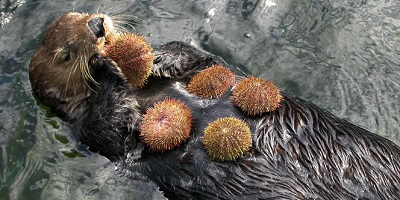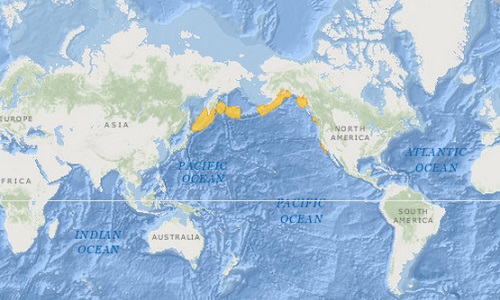Taxonomy

Sea otter eating sea urchins in the Vancouver Aquarium in British Columbia. Sea otters are considered an Endangered species by the IUCN.
- Kingdom: Animalia
- Phylum: Chordata
- Class: Mammalia
- Order: Carnivora
- Family: Mustelidae
- Genus: Enhyndra
- Species: Enhyndra lutris
o
o
Name
- Common name: Sea otter.
- Scientific name: Enhyndra lutris. Enhiyndra comes from the Ancient Greek word for “water” and lutris from the Latin word for “otter”.
Habitat
- Sea otters live in coastal areas, primarily in the ocean but they can walk on land. About 84% of foraging occurs in water at depths of less than 98 ft or 30 m. The rest occurs within a kilometer from shore.
- Their habitat includes kelp canopy, sand, silt and mud sea bottoms in rocky coastlines and barrier reefs that protects them from strong ocean winds.
Distribution
- There are tree subspecies of sea otter that occur in different geographical areas in the north Pacific.
- The Asian sea otter (Enhyndra lutris lutris) ranges from the Kuril Islands to the Kamchatka Peninsula in Russia.
- The Northern sea otter (Enhyndra lutris kenyoni) distribution ranges from the Aleutian Islands in the northern Pacific Ocean to Prince William Sound in Alaska and along the Pacific coast of Canada up to Oregon State in USA.
- The California sea otter (Enhyndra lutris nereis) occurs in central California, USA.
- Historically sea otters were distributed across the North Pacific Rim to Baja California, Mexico. Sea otters were almost extirpated for its fur.
- They are native to Canada, Japan, Mexico, Russia and United States.
- According to the IUCN Otter Specialist Group the world-wide population estimate for the sea otter is approximately 108,000 individuals.
Physical Features
- Sea otters are the smallest sea mammals.
- It is the heaviest of all 13 species of otters. The giant otter (pteronura brasiliensis) is longer but lighter.
- Their bodies are insulated by a thick fur coat and not by blubber as in other marine mammals. Their fur is the densest of any animal with about 100,000 hairs per square centimeter.
- Their fur is thick throughout the year. They do not have a molting season but they shed gradually and its hair is replaced all year round.
- The color of its fur is dark brown with silver speckles. Adults have lighter hair in its head, throat and chest.
- Their hind legs are longer than their forelegs with broad and webbed paws. Their forelimbs have retractable claws.
- Sea otters have loose skin under their forearms which serves as a pouch for food storage while eating or diving.
Weight and Length
- Adult sea otters weight between 31 and 99 lbs or 14 to 45 kg.
- Their length ranges from 3.28 to 4.9 ft or 1 to 1.5 m long.
Behavior
- Sea otters are diurnal and spend from 25 to 60% foraging depending on the availability of food. They spend the rest of their time grooming.
- Sea otters use rocks as tools to open shells.
- Only adult male sea otters are territorial and try to expel other males from it. Females move freely from territory to territory.
- They propel themselves in water by moving their tail and hind feet up and down with its forelimbs pressed against its chest.
- Sea otters can easily float because of the air trapped in its fur and their large lung capacity.
- They can swim at speeds of up to 5.6 mph or 9 km/hr.
- They eat while floating on their back.
- Sea otters rest together in groups called rafts or pods ranging from 10 to 100 same sex individuals.
Diet
- Sea otters are carnivores. They consume sea urchins, mollusks, snails, fish and crustaceans, basically any fish or marine invertebrate in their foraging grounds depending on what is geographically available.
Reproduction
- Male sea otters reach reproductive maturity at around 5 or 6 years of age while females at 4 or 5.
- They are polygynous and reproduce all year round.
- They mate and give birth in water.
- Females give birth every 1 to 2 years.
- These mammals undergo delayed implantation under which the embryo does not implant in the uterus until all physical conditions in the female are met, specially nutrition.
- Gestation time varies because of delayed implantation. It can range between 4 to 12 months.
- Litter size is 1, very rarely 2. Pups depend on their mothers for the first 6 months after birth.
- Newly born sea otters weigh from 3.1 to 5.1 lb or 1.4 to 2.3 kg.
- Male sea otters do not provide parental care.
Life Expectancy
- Female sea otters live from 15 to 20 years while males live from 10 to 15 years.
- Maximum longevity is 27 years in captivity.
Predators
- Its main predators are killer or orca whales, great white shark, sea lions, coyotes, brown bears and bald eagles.
Threats
- Conflict between sea otters and fisheries.
- Populations with low genetic diversity.
- Infectious diseases in certain populations are a significant cause of mortality.
- Oil spills are a major threat for sea otters as their fur loses its insulation properties. If oil is ingested or inhaled it can cause organ damage.
- Accidental trappings in commercial net fishing.
- Predation by killer whales.
- Loss of habitat due to logging in coastal areas.
Conservation Status
- The sea otter is considered an Endangered species by the IUCN Red List of Threatened Species. Its population has declined by more than 50% over the past 30 years.
- The sea otter population that occurs in central California, Enhyndra lutris nereis is listed on Appendix I of CITES. All other populations are listed on Appendix II of CITES.
- In the U.S. the US Fish and Wildlife Service is responsible for their conservation and management.
Interesting Facts about sea otters
- The sea otter population declined to approximately 2,000 individuals by 1911. The International Fur Seal Treaty of 1911ended the commercial fur trade and saved the sea otter population from further decline.
- It is estimated that about 2,600 to 4,000 sea otters died during the Exxon Valdez spill in Prince William Sound in Alaska in 1989.
- In 1969 efforts to reintroduce the sea otter to the Oregon coast were unsuccessful however its reintroduction to the Washington coast was highly successful. Today populations in Washington State are thriving and expanding.
- Its reintroduction in the wild during the 20th century is considered one of the greatest successes in marine conservation.
- Sea otters are a keystone species keeping the health of the marine ecosystem in check. They have a disproportionally large effect on its environment relative to their number.
- The sea otter is the heaviest member of the weasel family.
References and further research
IUCN Red List of Threatened Species – Enhydra lutris
University of Michigan Museum of Zoology – Enhydra lutris, sea otter
US Fish and Wildlife Service – Northern sea otter Enhydra lutris kenyoni
Smithsonian National Museum of Natural History – Enhydra lutris sea otter
The Animal Aging and Longevity Database – An age entry for Enhydra lutris

